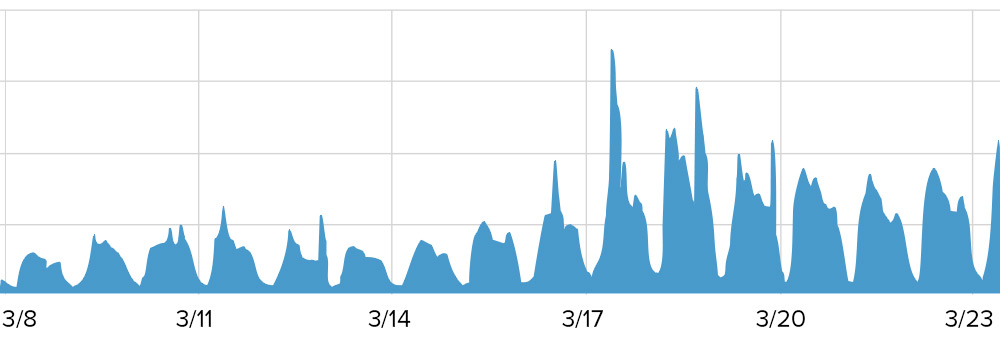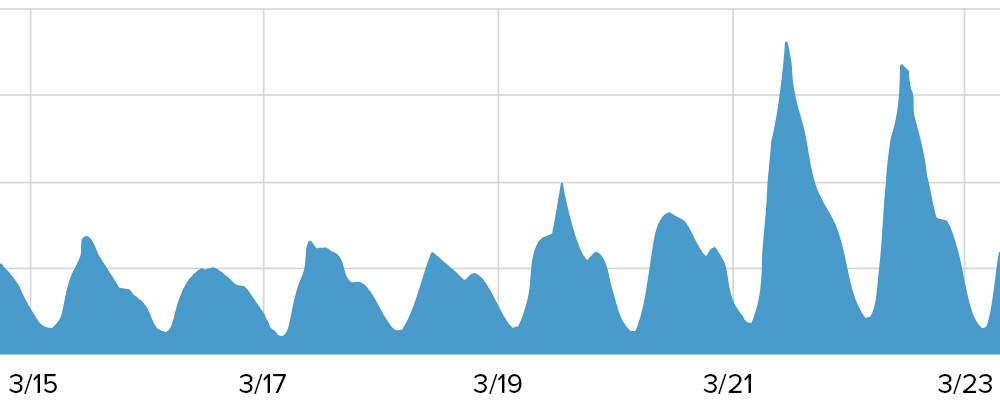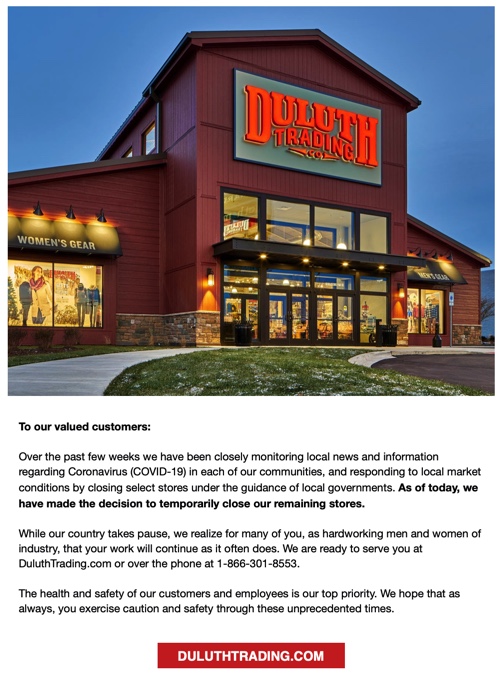Unfortunately, dealing with the current global Coronavirus pandemic is shaky territory for everyone. Many brick and mortar stores are having to shut down. However, online traffic seems to be hitting record highs, so much that eCommerce brands are increasing ad spend because COVID-19 is actually driving online sales. But are sites ready for the unexpected influx in traffic?
If you think about it, the dramatic increase in online shopping isn’t that surprising. With the sudden lockdown on traveling and socializing, people are looking (at least a few months) ahead to a pandemic-free future. But in the meantime, shopping helps.
Beyond the need to get the basic staples of daily living, escaping the #quarantinelife with online shopping provides the relief that many people are seeking. Sending their loved ones a gift, ordering some new workout clothes for their make-shift home gym, or picking out that bathing suit in hopes of a COVID-free summer. Online shopping helps people stay connected without breaking the strict rules of government mandated “social distancing.”
So, how can brands make sure they are ready when shoppers want to buy online during these uncharted times? Here are eight tips we’ve put together from our experience of working with over 1,500 eCommerce sites during traffic-heavy situations:
Is your eCommerce site ready for the influx in traffic? Find out today!
Top 8 tips for eCommerce brands during COVID-19:
1. Online traffic is coming: Prepare!
Because of government mandates, shoppers physically can’t go into most stores but still need to buy products, so they’ll be doing the majority of their purchasing online. Retailers that sell everyday/essential products will likely see a huge increase in traffic right away. This includes brands like Amazon, BJs, ButcherBox and Target. However, retailers that sell non-essential items will also likely see an increase in online traffic as consumers are spending more and more of their time housebound, and online shopping will be one of the ways they safely pass the time.
In fact, we are seeing online traffic increase heavily for brands in industries like home improvement, crafts, childrens’ activities, health & wellness, and apparel.
eCommerce is still up and running so online brands have an advantage during the current state of the market compared to solely brick and mortar businesses. As for brands that have both physical and online stores, like many apparel brands, they can’t shut down their shops completely as there are still seasonal goods to be moved. NOW is the time to sell, and retailers are getting creative to make sure they are moving that inventory. For example, some brands are using the stock from their closed down stores to supplement their online supply, while others are closing their physical stores but still offering “buy online, pick up at store.”
Here are some of the traffic patterns we are seeing in our customer base:
- Health & Wellness: 600% traffic spike (graph A)
- Home Improvement: 200% traffic increase, climbing towards 300% (graph B)
- Crafting: Holiday levels of traffic
Graph A

Graph B

Unfortunately, not all brands are ready to take on this amount of traffic, as this pandemic has completely blindsided the industry. As we saw during the 2019 Cyber 5 (Thanksgiving Day to Cyber Monday), most retail sites are not prepared (even when they know it’s coming!) to handle increased demand, resulting in many sites crashing.
For example, Costco couldn’t take the massive online holiday traffic, and as a result, its site crashed for several hours on Thanksgiving day and was inconsistent for multiple days after, resulting in an estimated $11 million in lost sales. Hopefully, Costco and other brands learned their lesson, and have since readied their sites for heavy-traffic situations instead of “waiting until next holiday season” to fix it.
It’s critical for eCommerce brands to prepare and optimize their sites to handle this dramatic increase in online traffic. If not, it will surely hurt brand reputations when shoppers are looking for some comfort and relief from a very scary time — not to mention a big loss in revenue.
Is your eCommerce site ready for the influx in traffic? Find out today!
2. Optimize for desktop
Another way the COVID-19 pandemic has flipped a switch is that the majority of online shopping traffic has moved from mobile to desktop.
 With people working from home, or just stuck in the house, the “on-the-go” benefits of mobile simply do not apply. Why go on your tablet or phone when you have a nice, big desktop screen in the next room? The same desktop you are spending all day on videoconferencing for work.
With people working from home, or just stuck in the house, the “on-the-go” benefits of mobile simply do not apply. Why go on your tablet or phone when you have a nice, big desktop screen in the next room? The same desktop you are spending all day on videoconferencing for work.
With a smoother checkout experience on desktop, brands should see less cart abandonment like we do with mobile, and more shoppers completing their purchases.
This will most-likely revert once we’ve made it through this pandemic and people are back on-the-go, but for now, make sure their online shopping experience via desktop is as seamless as possible.
3. Have adequate inventory available
Not having enough inventory isn’t good for anyone, so think ahead and prepare the right amount to have in stock. Especially if your brand sells anything considered “essential” during these times, (Costco, BJs, Target) you will most-likely run out quickly.
Non-essential items will be selling too. Just think, flowers, workout clothes, running shoes, home repair items, and spring clothing are all things that shoppers in quarantine can use to help make their lives feel a little more “normal.” So make sure you have the inventory to help get folks through this time, or suffer the consequences of the competition getting those sales.
4. Take your operations remote
From a company preparedness standpoint, eCommerce brands have a lot of systems to manage. Making sure that employees can manage those systems remotely and not just inside the office is critical.
If retail operations are not remote yet, try a “practice day” if you can, to run through how a day would look like when everyone is remote. That way you can work out any issues before it becomes government mandated. Employee safety is always a priority, and working from home will help reduce health risks.
5. Establish back-up plans for essential employee schedules (if they become ill)
If your operation still isn’t entirely remote, at least make sure essential employees are. Those are the people that need to avoid getting sick to keep operations running. In the case that any employees do get sick, set up an emergency back-up schedule to the best of your ability. It’s always important to have a plan in place, and many brands already prepare back-up schedules for high traffic times, like the Cyber 5.
6. Constantly communicate with customers
Now that you have your own plan in place, you can communicate it to your shoppers. Keeping them in the loop on your efforts to keep your employees and customers safe during this time is a great way to maintain control and show exactly how you are taking action.
For example, here is an email from Duluth Trading:

Keeping lines of communication open, consistently engaging with your customers, and letting them know how they can reach you with any concerns will instill the confidence they need to be loyal and repeat shoppers. Build up that trust and maintain those relationships, even if they are virtual at this time.
7. Be flexible to maximize productivity
Having people work from home is a necessity right now, but know that we will all see a decrease in productivity. This is not the fault of employees, as they are just trying to prepare for personal safety, which should be encouraged. As a company, try to focus on providing them with as much support as possible. Make schedules more flexible, have managers check in on them to see if they need to talk, encourage personal or mental health days, or send around helpful articles on how to deal with COVID-19 anxiety.
8. Communicate with vendors and 3rd parties
3rd party technologies and other vendors are vital to your site’s operations. If you haven’t had contact with vendors in a while, you should go through the motion of reaching out and saying: “Just making sure you guys are ready, how can we get in touch with you?”
This way, you will have a contact plan if anything were to affect your site. It would also be a good idea to take an inventory of all 3rd parties and browser extensions that are on your site now. Having full visibility into these elements will help if anything were to go wrong. If there’s a way to streamline issues that could affect site performance, now is the time to prepare.
eCommerce as a community
The most important thing to keep in mind is that we are all in this together. Here at Yottaa, we are prepared to assist in any way possible to ensure your online shoppers continue to have a fast and secure experience on your site. We are pros at ensuring everything runs smoothly during times like this, and our clients experienced zero downtime during this past Cyber 5.
If you need help with any of the tips above, don’t hesitate to reach out. Stay safe!

